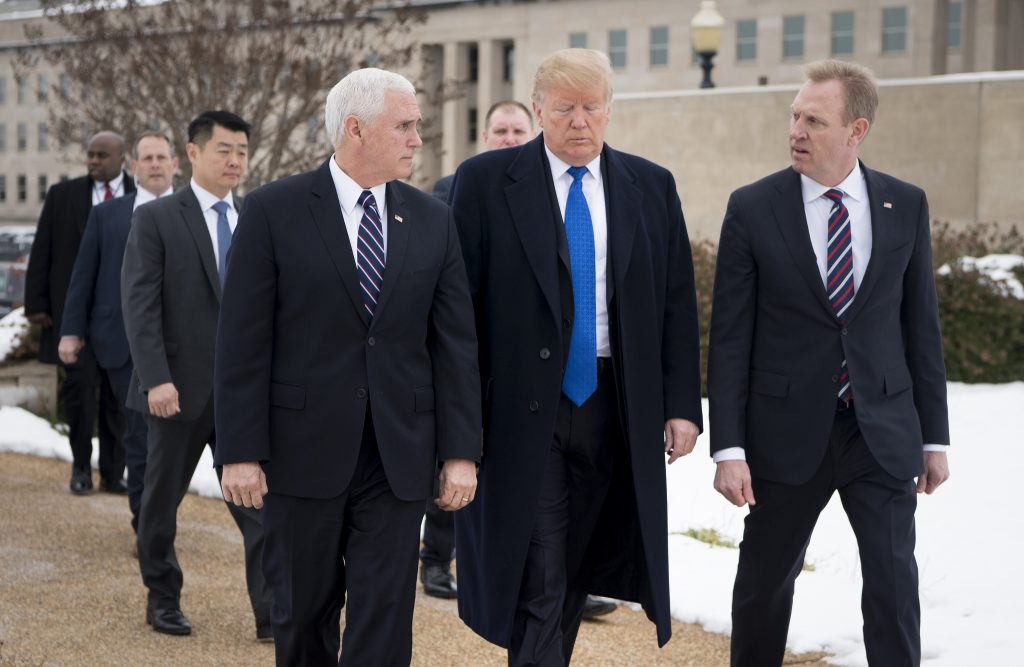Budget 2020: A CR, Sequestration And Some Compromises?
Posted on

Patrick Shanahan (far right) with President Trump and Vice-President Pence
The White House defense budget for 2020 falls short of commitments made and actual requirements to meet the military’s strategy, but it begins to shift priorities and start the long process of investing in long-term competition with China and Russia.
Washington still lacks the budget details for another week, but here are some initial reflections on the 2020 defense request likely to endure.

Mackenzie Eaglen
The 2020 budget makes some clear tradeoffs with ‘winners’ and ‘losers.’ Examples abound:
- The early retirement of the USS Harry S. Truman at midlife;
- Reductions in the Joint Strike Fighter planned buy to purchase F-15EXs;
- Fewer Bradleys and Joint Light Tactical Vehicles for the Army;
- A slight de-emphasis of the European Deterrence Initiative, rejiggered shipbuilding investment portfolio, and continued growth in space, cyber, artificial intelligence, hypersonics and munitions.
Congress will surely disagree with many of these, but at least it will be a more thoughtful debate than in recent years. This time lawmakers will be talking over the right ideas, concepts and requirements to succeed in our competition with Russia and China. Thankfully, policymakers have been increasingly sensitive to the faltering “barbell investment strategy” and inclined to add procurement dollars where the Pentagon fell short. That trend is likely to continue in this budget cycle, although not as generously as recent years.
The Pentagon still needs to come up with more robust analytical rigor to put meat on the bones of the National Defense Strategy, so understanding where investments in “conflict” end and “competition” begin remains opaque.

F-35 production line
Under former Defense Secretary Jim Mattis, the services were left to their own devices to interpret his overwhelming focus on lethality based on the boss’ intent. But that meant different solutions across the board and soon a kitchen-sink programming process where the answer to any question was, “it invests in lethality!”
An emphasis on readiness and next-generation research and development continues apace—as was the focus of the last administration—but there are notable swings and new investments underneath the R&D umbrella, ones that are primarily focused on China.
Congress will need to take a hard look at readiness this cycle, however, in light of a strategy taking a longer view and decide if the ever-rising readiness bills for the “fight tonight” are still the right call relative to risk. The answer is surely classified but there needs to be a public examination of the key differences in a program prioritizing warfare versus one attempting to win a generational competition and avoid conflict altogether.
The Defense Department is understaffed at senior levels across the board, which makes it harder to whip up support for a two-year budget deal. The budget documents are more helpful than in recent years with data comparing year-over-year dollars in enacted vs. requested. Also useful to the Hill is the clear and consistent accounting for the base budget dollars stuffed into the war spending account (OCO) to make transparency much easier. (Remember just several years ago when Pentagon leaders wouldn’t even admit there was any base money in OCO?) And some briefers have been more candid than usual. For example, Air Force officials are quick to admit they didn’t ask for new fourth-generation tactical fighters but were directed to buy them. Since the money was “gifted” to the service, there was not as much pushback.
Even with all of these encouraging signs as part of the budget rollout, there are too many vacancies in Senate-confirmed positions across the Pentagon at a time of substantial uniformed leader turnover, when too many personnel serve in an “acting” or “performing the duties of” capacity, and too many talented leaders are leaving service too early. All of this presents many challenges for the 2020 budget request and how likely Congress is to go along with the most controversial decisions therein. The empty billets are most worrisome because there is no 2020 “masterpiece” budget for the military without a federal-government-wide spending deal for 2020 and 2021 that the White House and Congress can agree to for defense and non-defense spending first.
Making a budget deal was already going to be hard enough with the Democrats winning the House, and on the heels of the second government shutdown in two years. Essentially half of Congress was not in office when the original Budget Control Act passed, and new members need educating about why the law needs revising. Vacant offices at the Pentagon will mean less urgency for deciders to cut a deal, probably leading to another Continuing Resolution to start the fiscal year in October and an onslaught rush job creeping up dangerously close to sequestration’s ticking time bomb in January.
The good news is that the goal posts between the parties to settle on a defense topline are unusually close and relatively in sync at this point in the process. House Budget Committee Chairman John Yarmuth predicted last month in Politico that “Democrats would advocate for a defense spending topline of $720 billion to $735 billion for the coming 2020 fiscal year.”
That is an agreeable starting point for negotiations so long as the other side remembers that the price to get to “yes” will surely be parity (or close to it) for non-defense increases.
Mackenzie Eaglen, a defense guru at the American Enterprise Institute, is one of the best defense budget crystal ball readers around. Eaglen is a member of the Breaking Defense Board of Contributors.
Subscribe to our newsletter
Promotions, new products and sales. Directly to your inbox.
